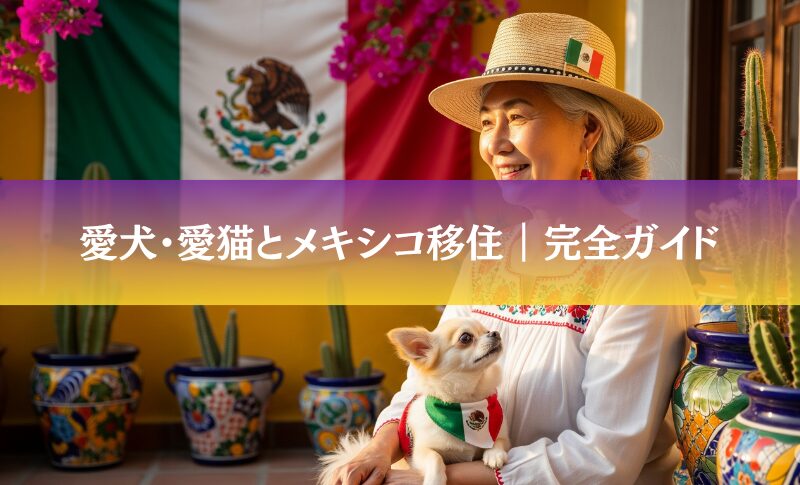To those of you who are considering moving to Mexico or staying for an extended period of time with your beloved pets. There are many obstacles to overcome when taking animals abroad, such as the complexity of quarantine procedures, strict documentation requirements, and the physical hurdle of long flights.
In this article, we will organize the latest information necessary to bring your pet from Japan to Mexico,9-month preparation scheduleThe following is a step-by-step explanation of what you need to do along the way. Please use it as a practical guide to avoid delays and errors in procedures and to ensure a smooth trip to Japan.
🚨 Why do you need 9 months to prepare?
I thought Mexico wasn't so tough." Many may feel that "Mexico is not so strict. However, the actual preparation time is rather influenced by theWhen returning to Japanconditions.
⚠️ Check it out!
Mexico is classified as a "non-clean" area for rabies, and therefore one of the strictest quarantine conditions in the world applies when returning to Japan from Mexico. Of particular importance is that after rabies antibody titer testing180-day standbyIf the 180-day period has not been exhausted prior to departure from Japan, your pet will be detained at the animal quarantine station for up to 180 days. If this 180-day period has not been fulfilled prior to departure from Japan, your pet will be detained at the animal quarantine station for up to 180 days upon your return.
Therefore, a successful trip to Mexico requiresSimultaneous "pre-departure" and "return home" preparationsIt is essential to proceed with
For more information on rabies, please refer to this article.
📅 9-month roadmap
🗓️ Step-by-step preparation schedule
For more information on microchipping, please see the following article.
🏥 Veterinary Preparation Process
Microchipping and initial veterinary consultation
Formal preparation begins when the microchip is installed according to ISO 11784/11785 standards. Vaccinations and tests performed prior to chip installation are considered invalid for quarantine purposes, so be sure to follow the procedure.
rabies vaccination
After the chip is installed, two rabies vaccines are administered according to a set schedule.
💉 Vaccine Schedule
- 1stAfter the chip is installed and after 91 days of age
- 2ndVaccination: at least 30 days after the first dose and within the period of validity of the first vaccine.
Rabies antibody titer test
The most difficult part of re-entry to Japan: blood is drawn after the second vaccine and antibody titers are measured at a laboratory designated by the Ministry of Agriculture, Forestry and Fisheries.
📈 180-day waiting list flow
standby
Antibody titer > 0.5 IU/mLis the standard. Since the date of blood collection is the starting date for the 180-day period, please keep the original certificate in a safe place.
Schedule a free online consultation
🇲🇽 Mexico Entry Requirements
📋 Checklist
Although not required in Mexico, it is strongly recommended that you wear it beforehand, as it will be necessary when re-entering Japan.
Mandatory for dogs and cats over 3 months of age. Vaccination certificates must be in English or Spanish and state the date of vaccination and expiration date.
Conduct and document external/internal parasite control such as fleas and ticks.
Although not required, it is recommended to have it in English or Spanish to avoid immigration problems.
💡 Point
- Documents are in English or Spanish
- Prepare an original and several copies and keep them separate
- Since the area is rabies-free, preparations for returning home will proceed in parallel.
Microchips and Individual Identification
Not required by Mexican authorities, but required for re-entry into Japan.ISO standard chipshould be installed.
rabies vaccine
Vaccinations are required for both cats and dogs. Please have certificates ready within one year prior to travel.
Parasite Control
Within 6 months of travelFlea and tick control will be conducted and recorded in the If parasites are identified at the time of entry, there is a risk of denial of entry.
For more information on vaccinations, click here.
health certificate
Although not required under the current rules, it is recommended that a veterinarian issue the certificate within 15 days of travel.
📄 Document Preparation Flowchart
📋 4-step procedural process
- Proof of microchip installation
- Proof of rabies vaccination
- Antibody titer test results
- Health Certificate (English/West)
- Submit application for export inspection
- document review
- health checkup
- Export quarantine certificate issued
- Transport Reservation Confirmation
- Certification Document Check
- Crate Inspection
- check-in
- SENASICA Counter
- Submission of Documents
- health check
- entry permission (to a country)
⚠️ Important Notes
- Prior confirmation is required to ensure that all documents are complete.
- Inquire early as regulations vary by airline.
- Follow the instructions of SENASICA staff upon arrival.
- Consult a local veterinarian if there is a problem.
✈️ Practical Guide to Air Transportation
Major airline regulations
There are no direct flights between Japan and Mexico, so flights are via. Let's sort out the transit destinations and airline options.
🌐 Main Routes via
- via the U.S.American Airlines / United Airlines / Delta Air Lines
- via EuropeLufthansa / Air France / KLM
- via AsiaKorean Air / Asiana Airlines (via restricted destinations)
Preparation of crates (cages)
Prepare a crate that meets International Air Transport Association (IATA) standards. The standard size is for your pet to be able to stand up and turn around.
📦 Points to consider when choosing a crate
- Compliant with IATA standards
- Sufficient ventilation and sturdiness
- Water supply fixtures can be installed
- Interior space for pets' comfort
💰 Cost and budget estimates
The cost of transporting pets to Mexico varies depending on the size of the pet, the destination, and the airline. Please get a rough idea of what to expect and budget accordingly.
💵 Approximate cost items
Approximate cost: around 100,000 yen
Approximate cost: around 50,000 yen
Approximate cost: 150,000-400,000 yen
💡 Budget Planning Tips
The total amount is300,000-550,000 yenIt is recommended that you assume about Get estimates from several companies, as they vary greatly depending on the size of the pet, the route, and the availability of contractors.
🚀 Key to Success
5 🎯 Tips
- Early Preparation9: Acting backward from 9 months in advance
- Accuracy of documentsAiming for: Zero errors or omissions in the description
- Utilization of ExpertsClose cooperation with: veterinarians and transporters
- risk managementSecure a preliminary schedule and contingency plan
- health care (e.g. for the aged)Maintain optimal physical condition right up to the moment of departure.
Common mistakes and countermeasures
⚠️ Failures to avoid
- lack of preparation180: Disregarded the day waiting machine.
- clerical error (usually in a document): incorrect chip number or date
- Overlooking airline regulations: Breed, crate restrictions, etc.
- Ignore seasonal restrictions: Missing the summer transport ban period.
📞 Professional Support
Pet travel to Mexico is a long-term commitment. Small mistakes can lead directly to major delays and additional costs. Consult with experienced professionals to ensure a safe and reliable procedure.
🌟 Safe and Secure Travel Support to Mexico
PetAirJPN offers a 9-month full support program. Let us take care of all the hassle and make your life in your new country easier.
- 9 months of tiered support
- Medical procedure representation through veterinary cooperation
- Document preparation, translation, and application on behalf of our clients
- Airline Selection & Transportation Arrangement Optimization
- 24-hour emergency support
- Local Japanese language support
Feel free to contact us 📱 on line 24 hours a day!
Free initial consultation - no pestering sales pitch
![Support for pets traveling and moving overseas|PetAir JPN [Official] for international transportation and quarantine procedures for dogs and cats Support for pets traveling and moving overseas|PetAir JPN [Official] for international transportation and quarantine procedures for dogs and cats](https://petair.jp/wp-content/uploads/2024/08/main_logo.png?1766898697)



Comment